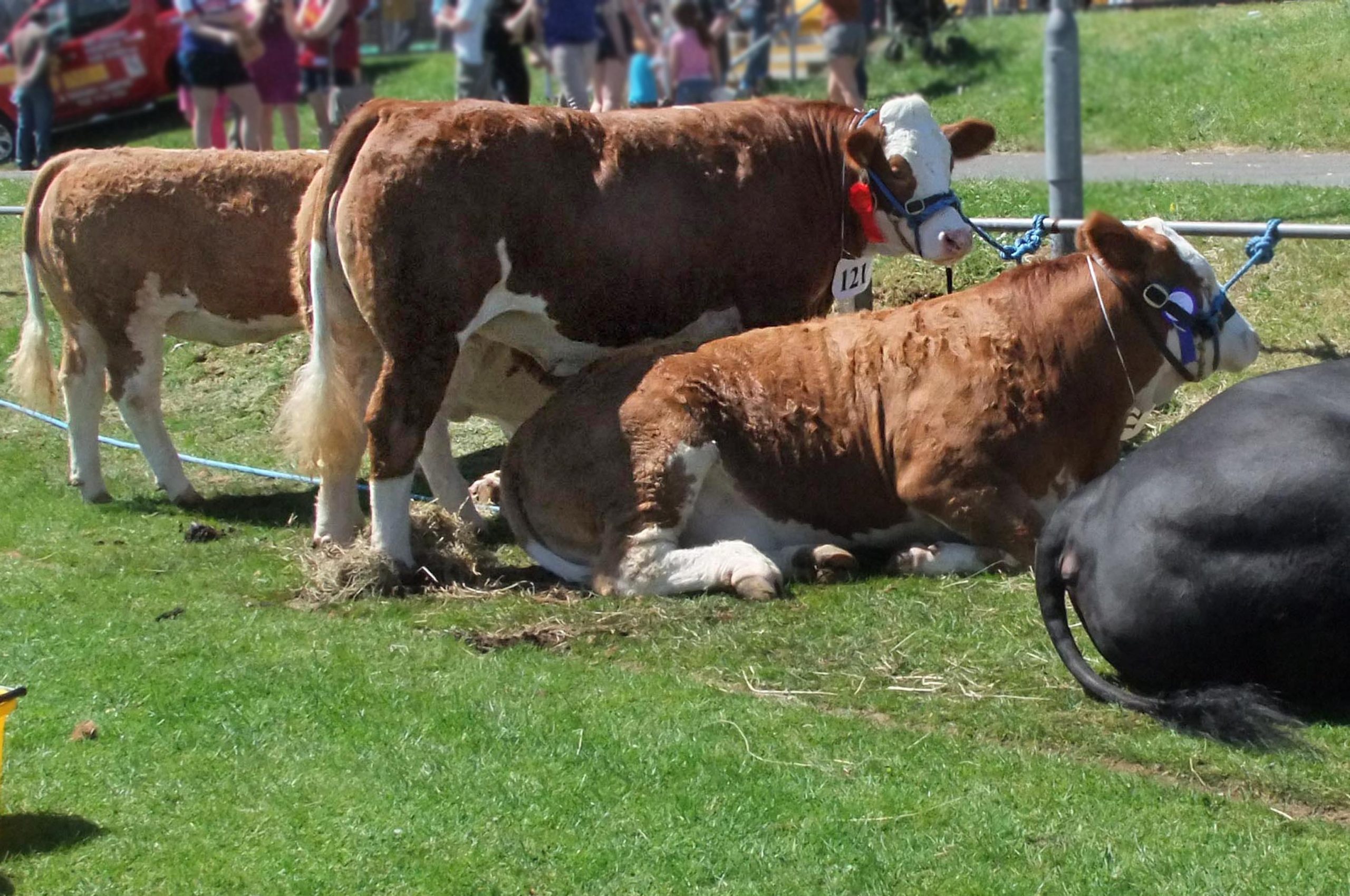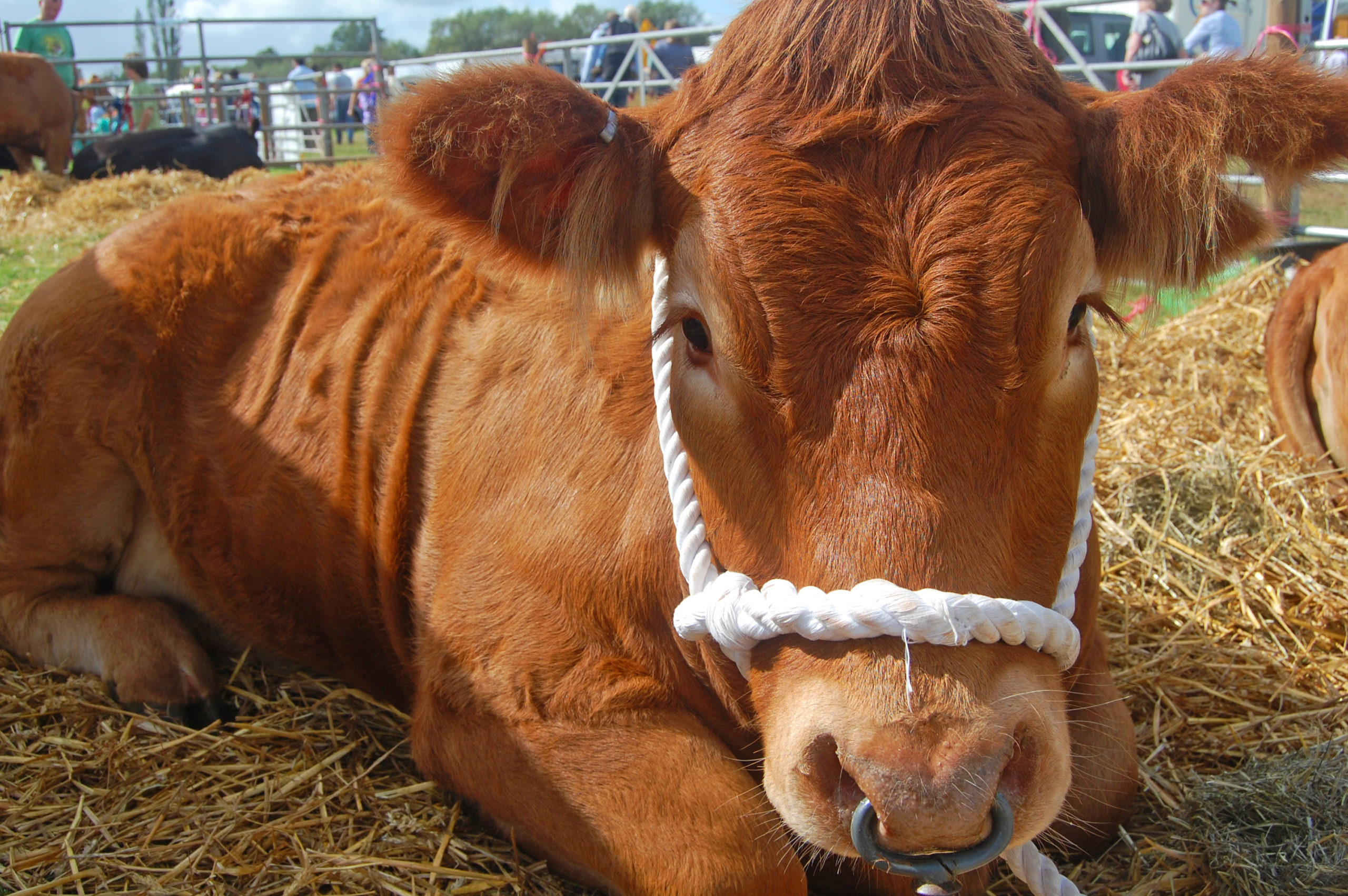This Q&A explains the pre- and post-movement TB testing requirements for cattle from England moving to agricultural shows in other parts of England, Wales and Scotland.
Due to differences in legislation within GB, if you are not based in England, please check the relevant guidance for the TB testing rules for cattle on holdings in Wales and Scotland. In addition to carrying out any pre- and/or post-movement TB testing, cattle keepers must also abide by standstill rules which apply for cattle returning from shows.

Read our summary of the pre- and post-movement testing requirements for cattle in England moving to shows.
An agricultural show is defined as a gathering of livestock for showing, sale or exhibition, where the primary purpose is showing the animals. Shows are licensed by APHA in England under the Animal Gatherings Order (England) 2010.
Cattle visiting shows present a risk for TB spread. Bovine TB can spread between cattle at shows either directly, through very close or nose-to-nose contact, or indirectly via contaminated shared equipment and environment. The risk is likely to be higher in an enclosed space (a marquee for example) or where cattle from different herds are kept on the showground for extended periods of time. To reduce this risk, statutory pre-and post-movement TB testing rules apply for movements of cattle to and from shows, unless specific exemptions apply.
Yes. Show organisers can submit a self-declaration to APHA stating that they are exempt from the requirement for pre- and post-movement testing of cattle attending their show. To do so they must meet certain criteria (see below). A show that does not meet the criteria is referred to as a “non-exempt” show and depending on the TB surveillance testing frequency of their herd of origin, cattle may need to be pre- and/or post movement tested to attend.
Yes. Exemptions include movements of cattle which meet the following criteria:
- cattle moving to a show where all bovine animals are present for less than 24 hours on site
And
- for shows in England, no cattle are to be housed i.e. in a covered area with sides (includes marquees)
- for shows in Wales, no cattle are to be housed i.e. in a covered area with or without sides (includes marquees)
If any cattle are to be kept at the show location for a period which exceeds 24 hours, all eligible cattle moving to that show will be subject to pre- and post-movement TB testing requirements as applicable.
Compulsory pre- and post-movement testing rules apply for cattle from certain herds moved to and from shows. The following table summarises the requirements for cattle from England moving to and from non-exempt shows.
Location of origin herd (England) | Location of show | Pre-movement testing required to move to show? | Post-movement testing required on return from show? |
LRA | LRA | No for animals from herds on four-yearly surveillance testing | No |
LRA | Edge Area and HRA | No for animals from herds on four-yearly surveillance testing | Yes within 60-120 days of return to the holding of origin**
|
LRA | Wales | No for animals from herds on four-yearly surveillance testing Yes for animals from herds on annual or more frequent surveillance testing* | Yes within 60-120 days of return to the holding of origin**
|
LRA | Scotland | No for animals from herds on four-yearly surveillance testing | No |
Annual surveillance testing parts of the Edge Area | LRA | Yes | No |
Annual surveillance testing parts of the Edge Area | Annual surveillance testing parts of the Edge Area | Yes | No |
Annual surveillance testing parts of the Edge Area | Six-monthly surveillance testing parts of the Edge Area and HRA | Yes | Yes within 60-120 days of return to the holding of origin**
|
Annual surveillance testing parts of the Edge Area | Wales | Yes | Yes within 60-120 days of return to the holding of origin**
|
Annual surveillance testing parts of the Edge Area | Scotland | Yes | No |
Six-monthly surveillance testing parts of the Edge Area and HRA | LRA | Yes | No |
Six-monthly surveillance testing parts of the Edge Area and HRA | Edge and HRA | Yes | No |
Six-monthly surveillance testing parts of the Edge Area and HRA | Wales | Yes | No |
Six-monthly surveillance testing parts of the Edge Area and HRA | Scotland | Yes | No |
Notes
1. Cattle under 42 days old are not eligible for pre-movement testing.
2. The information in the table relates to statutory pre- and post-movement testing requirements. Please note that some shows require pre-movement testing even if it is not compulsory under the legislation, therefore exhibitors are advised to check with the show organiser well in advance of the show.
* Cattle herds in the LRA subject to annual or more frequent surveillance testing are those that regularly source cattle from higher TB risk areas, raw milk producers, or herds subject to radial testing.
** Animals subject to compulsory post-movement testing must not move off the destination holding until the test is completed with a negative result, unless transported to slaughter (directly or via a slaughter gathering), or to a Licensed Finishing Unit, Approved Finishing Unit or Exempt Finishing Unit.
Show organisers must either submit a self-declaration to APHA stating that cattle attending their show are exempt from pre- and post-movement TB testing requirements, or:
- in England, notify all cattle keepers attending the show that those with herds on annual (or more frequent) surveillance testing will be required to pre-movement test, and those with herds in the LRA and annual surveillance testing parts of the Edge Area will be required to post-movement test their animals on return from the show
Or
- Notify all cattle keepers attending the show that they will be required to pre-movement test their animals, including cattle from herds in the LRA of England if the show organiser requires it
Shows that are able to declare cattle attending their show exempt from pre- and/or post-testing requirements are those where:
- no cattle will be held on the showground for 24 hours or more from the time of arrival at the showground
- for shows in England, no cattle are to be housed i.e. in a covered area with sides, which includes marquees
- for shows in Wales, no cattle are to be housed i.e. in a covered area with or without sides, which includes marquees
Show organisers in England will need to:
- submit a self-declaration to the Pre-movement Testing Monitoring Unit (PTMU) at the APHA Customer Service Centre (CSC) in Exeter if they qualify for exemption
And
- ensure that all cattle keepers attending the show are aware of the pre- and post-movement testing requirements for that show as applicable
Contact details for CSC Exeter
Telephone: 03000 200 301 and choose the relevant options for APHA
Email: customeradvice@apha.gov.uk
Postal address: Pre-movement Testing Monitoring Unit, Animal & Plant Health Agency, Isca Building, Manley House, Kestrel Way, Exeter, EX2 7LQ
Ultimately it is the keeper’s responsibility to ensure that statutory pre- and post-movement TB testing requirements are met. Guidance on statutory pre-and post-movement testing requirements for cattle is available on GOV.UK. The show organiser will also be able to advise you on the specific requirements for their show and whether exemptions apply.
Yes, you should keep documentary evidence of cattle that you move under these exemptions for at least three years. A declaration from the show that it is eligible for exemption from pre- and/or post-movement TB testing requirements would be considered relevant evidence. You may be asked for copies of relevant evidence by those who purchase your cattle or in the event of enforcement action.
A negative pre-movement TB test result is valid for 60 days from the date of injection of tuberculins.
Yes. Animals can be moved to more than one show during the post-test period, provided that the last movement to the show (or to slaughter if applicable) is completed within 60 days of the date of injection of tuberculins. You should not book a TB test to take place within 60 days of completion of the previous TB test as this will not be regarded as an authorised test. If cattle are attending multiple shows throughout the season, remember that standstill requirements also apply. Cattle returning home from a show will trigger a six-day standstill for all cattle on the holding.
No. The animals cannot move off the holding (except to slaughter or for veterinary treatment) until a post-movement test has been completed within 60-120 days with a negative result. Cattle keepers with herds in the LRA or annual surveillance testing parts of the Edge Area who wish to send stock to multiple shows held in other parts of England or Wales may defer the post-movement test by keeping their animals outside of these lower TB incidence areas between shows.
No, not in England. The pre-movement test carried out to allow an animal to move to a show only needs to be valid for that movement and the 60-day validity window can expire whilst at the show. In the case of attending multiple shows using the same pre-movement test, the test would need to be valid for the duration of all movements on to all the shows. In Wales, the pre-movement test must cover the movement onto the show and off the show (unless an exemption applies e.g. off to slaughter).
Best practice biosecurity when attending shows
In addition to pre- and post-movement TB testing, best practice biosecurity reduces the risk of bovine TB and other infectious diseases spreading between animals attending shows. Good management practices and hygiene can help you achieve best practice. Also bear in mind that standstill restrictions apply when returning from shows.

When at the show
- Facilities are usually provided at shows for you to clean and disinfect your boots and wash your hands, so where available, please use them and consider bringing your own supply.
- House cattle in their designated stalls throughout their stay at the show, ensuring adequate separation from other cattle, and avoiding nose to nose contact.
- Clean the stall base and fill with new bedding on arrival.
- Supply animals with their own water in the stall and avoid using communal water troughs.

- Bring your own feed and supply it in a trough; avoid feeding it on the ground. Store any unused feed in pest-proof containers.
- Ensure cross contamination of faecal matter run-off does not occur between stalls.
- Do not share grooming or handling equipment.
- Do not graze cattle in communal areas such as the show ring.
- Restrict animal movements around the showground to only what is required.
- If you suspect notifiable disease when at the show, tell the show organiser immediately.

When leaving the show
- Use the on-site facilities to wash your hands and clean and disinfect your footwear/protective clothing before you leave the showground.
- Clean and disinfect your livestock vehicle on site before leaving if at all possible. Any vehicles entering the animal area or used to transport animals to the show should have their wheels and wheel arches cleaned and disinfected before leaving the show.

When returning home
- Dispose of used bedding and thoroughly clean and disinfect the livestock vehicle used to transport animals to and from the show.
- Consider isolating animals returning from a show from the rest of the herd for at least 60 days.
- For animals returning from shows not subject to compulsory post-movement testing, consider isolation and voluntary post-movement testing.
- If you see any signs suspicious of notifiable disease in cattle that have recently returned from a show (or in any other animals on the holding), contact APHA to report it immediately on 03000 200 301, even if out-of-hours.
